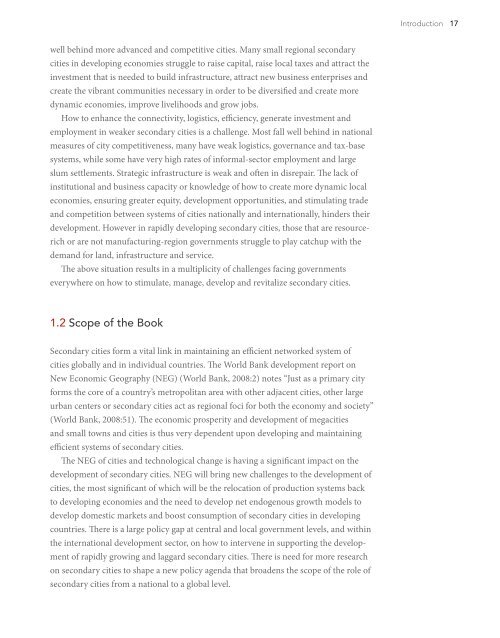DYhWN
DYhWN
DYhWN
You also want an ePaper? Increase the reach of your titles
YUMPU automatically turns print PDFs into web optimized ePapers that Google loves.
Introduction 17well behind more advanced and competitive cities. Many small regional secondarycities in developing economies struggle to raise capital, raise local taxes and attract theinvestment that is needed to build infrastructure, attract new business enterprises andcreate the vibrant communities necessary in order to be diversified and create moredynamic economies, improve livelihoods and grow jobs.How to enhance the connectivity, logistics, efficiency, generate investment andemployment in weaker secondary cities is a challenge. Most fall well behind in nationalmeasures of city competitiveness, many have weak logistics, governance and tax-basesystems, while some have very high rates of informal-sector employment and largeslum settlements. Strategic infrastructure is weak and often in disrepair. The lack ofinstitutional and business capacity or knowledge of how to create more dynamic localeconomies, ensuring greater equity, development opportunities, and stimulating tradeand competition between systems of cities nationally and internationally, hinders theirdevelopment. However in rapidly developing secondary cities, those that are resourcerichor are not manufacturing-region governments struggle to play catchup with thedemand for land, infrastructure and service.The above situation results in a multiplicity of challenges facing governmentseverywhere on how to stimulate, manage, develop and revitalize secondary cities.1.2 Scope of the BookSecondary cities form a vital link in maintaining an efficient networked system ofcities globally and in individual countries. The World Bank development report onNew Economic Geography (NEG) (World Bank, 2008:2) notes “Just as a primary cityforms the core of a country’s metropolitan area with other adjacent cities, other largeurban centers or secondary cities act as regional foci for both the economy and society”(World Bank, 2008:51). The economic prosperity and development of megacitiesand small towns and cities is thus very dependent upon developing and maintainingefficient systems of secondary cities.The NEG of cities and technological change is having a significant impact on thedevelopment of secondary cities. NEG will bring new challenges to the development ofcities, the most significant of which will be the relocation of production systems backto developing economies and the need to develop net endogenous growth models todevelop domestic markets and boost consumption of secondary cities in developingcountries. There is a large policy gap at central and local government levels, and withinthe international development sector, on how to intervene in supporting the developmentof rapidly growing and laggard secondary cities. There is need for more researchon secondary cities to shape a new policy agenda that broadens the scope of the role ofsecondary cities from a national to a global level.


